Abstract
The most recent major event that has marked the whole of humanity, the COVID-19 pandemic, has meant a major change in lifestyle, from a digital perspective. The whole activity was based on the online environment, each person, depending on the basic activity, being forced to develop their digital skills in a short time. Thus, pupils, students, teachers, and employees in various sectors of activity, in the private sector or the budget, really gave the test of digital skills, in a context not of assessment of learning, but of assessment for learning. Each of us has been able to see our own level of digital skills and has taken action accordingly, all with the common denominator of improving digital skills and making the most of the digital devices available. What do digital skills entail? One of the eight key competencies, digital competence, aims, in general, at the efficient, creative and responsible use of information and communication technologies. The present study aims to draw a package of digital skills starting from the identification of the challenges of contemporary reality.
Keywords: Digital skills, information and communication technologies, information society, online environment, transversal skills
Introduction
We live in the age of information technology. The passage of the coronavirus pandemic represented for the information society a huge leap in terms of the digitalization of professional, social and cultural activity, generated by the need to adapt quickly to the restrictions imposed by this situation.
The importance of the studied topic results precisely from the fact that it is a topical topic, in the current context digitalization being not only an objective, but also a necessity, even a way of life. Social distance and teleworking, including online education, due to coronavirus, have brought to the fore digital technologies, computer applications, online platforms, digital networks, which are essential in providing information and distance learning tools. They offer not only a large amount of information, but also many and varied types of activities that are real learning opportunities, their range ranging from sharing personal skills to proposals for collaborative activities, on topics from various levels - art, economy, education, etc. Accessing them requires, of course, a certain level of digital skills, each person thus testing not only their ability to use certain devices, but also that of familiarization with the use of software / applications useful in everyday activity.
State the Problem
In this context, we considered it appropriate to formulate the following research issue: What are the categories of digital skills needed by an employee in the contemporary information society?
Research Questions
What are the defining characteristics of contemporary society?
What is the connection between data-information-knowledge?
What data characterizes the Romanian information society and how do they correlate at European level? • What concrete measures are set out in national and European policy documents to improve the digitalization of contemporary society?
What categories of digital skills are present in the training profile of an employee in the contemporary information society?
Purpose of the Study
The aim of this study is to inventory the main challenges of the information society in the crisis situation generated by the coronavirus pandemic and to structure a digital skills model suitable for successfully crossing a similar situation.
Research Methods
The investigative approach on digital skills required of an employee in the contemporary information society is based on the analysis of documents. In approaching this topic, the study of the literature and the analysis of other studies addressing this issue have contributed, through the data collected, processed and interpreted, to the structuring of a package of digital skills in line with the challenges of the contemporary information society. The analysis of the documents was ascertainable and exploratory, and the information was analyzed both horizontally, in various categories, and vertically, following their evolution over time.
From the industrial society to the information society
Conceptual approaches to the information society
The last three centuries of human history were marked by the transition from an agrarian society to an industrial one, then to an information society (Figure 1).

The successor of the industrial society, the new society, marked by a growing volume of information that can be accessed by more and more people, with an ever-increasing speed of circulation due to new technologies, is found in the literature under various names. Thus, the synonymous series includes formulations such as(Table 1).
Analyzing the main characteristics associated with the names of contemporary society, we find the presence of several common elements: ►technology becomes the core of the life of the individual and any organization or community; ►the essential attributes of technology are speed, variety, a large volume of information, ubiquity in all professional environments and in personal life; ►mediation of personal and professional relationships and experiences; ►roboting; ►personalization of many activities or procedures; ►Saving time and costs. We notice that the balance between the positive and the negative aspects is difficult to establish, the balance tilting depending on the perspective from which we look at the technology - personal, professional, of the businessman, of the employee, etc.
Date. Information. Knowledge
Although, in everyday speech, these concepts are often used as synonyms, they have a distinct meaning, the real meaning being acquired when they are introduced in a semantic context.
Data represent quantitative values of facts, processes, phenomena. They take on significance in the context in which they are used.
The information contains semi-structured data, on the basis of which decisions can be made. Having information guides us in predictable or unpredictable situations.
Today, information has become a real element of production - it is sold, bought, collected, analyzed, processed, transmitted, received. Correct, complete, efficient information always provides an advantage to the person or company in the market. Whoever controls the information can have the power.
With the advent of the computer and the Internet, there has been a real information revolution, which has substantially facilitated the process of collecting and processing information, with effects in terms of time and costs of making a decision.
Philip Kotler (2008) considers the information to be the fifth most important resource for a company, along with money, materials, machinery, and people (Figure 2).

Access to information is now facilitated by technological innovations. The media are numerous, varied, and fast, along with the print media, radio, television, an important place occupied by the Internet, considered the most flexible medium of information. If access to all these information media is within everyone's reach, an extremely important issue is the credibility of the information sources and the individual's ability to select and critically analyze the information.
is assimilated information, and its possession is influenced by psychological factors, the level of culture of each individual. "Unlike,means beliefs and commitment," said two Japanese scholars in 1995, Ikujiro Nonaka and Hirotaka Takeuchi (1995), authors of.
In the vision of Alvin Toffler ("Future shock"), since the ‚70s of the last century, knowledge is presented as the most important economic resource for an advanced society, even more important than labor or raw materials. Knowledge, with information as its raw material, becomes a priority resource for both enrichment and military power. This idea is continued in the volume "The Third Wave" (1983), each of the three waves representing the agricultural revolution, the industrial revolution and the computer-based revolution.
Information Society - Challenges and Solutions
Data on the development of the information society in Romania
According to the National Institute of Statistics, from the comparative analysis of the indicators used in characterizing the degree of development of the information society in Romania, in recent years there have been constant increases, in terms of:
- Employee use of the computer;
- Use of fixed and mobile internet connections at the enterprise level;
- Number of broadband internet subscriptions.
According to EUROSTAT data (European Union, 2021), in the last 10 years, the internet access and broadband connection at family/household level in Romania have registered a constant increase from one year to another, Romania approaching the European average. If the EU average for internet access varies by only 3%, respectively from 95% in 2010 to 98% in 2021, in Romania we see an increase of 12% from 2010 to 2015 (from 79% in 2010 to 91% in 2021), in the last 5 years there has been a variation of the percentages, with decreasing trends towards 81% in 2020 and with a spectacular return in 2021, when it reaches the highest value so far, namely 91% (Figure 3).
Regarding the broadband connection, it has increased by 100% in the last 12 years, from 42% in 2010 to 84% in 2019 and 88% in 2021 (Figure 4).
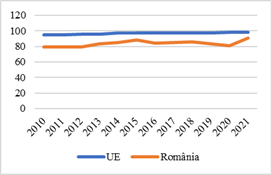
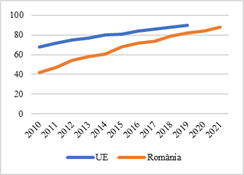
Digital reform in Romania
National Strategy on the Digital Agenda for Romania 2020 (p. 18) specifies four areas for action:
- eGovernment, interoperability, cybersecurity, cloud computing, open data, big data, social media
- ICT in Education, Health, Culture and eInclusion
- eCommerce, research and development and innovation in ICT
- Broadband and digital service infrastructure.
The personal computer and the internet connection have become features present in all professional environments and in more and more families. Geographical distances and borders have disappeared as an objective obstacle to the transmission of information.
Paradoxically, the rapid progress of new technologies facilitates and, at the same time, requires the digitization of the world. There is more and more talk of artificial intelligence, robotics,andLike any major transformation in human history, digital transformation influences the way people live, work, learn, interact. The effects of digitalization are already being seen - the disappearance or replacement of some professions, the emergence of new ones (European Commission, 2018, pp. 1-2), which justifies the need to develop digital skills in order to maintain them at a level of adaptation appropriate to new developments. information and communication technology (ICT), as also concluded by Fraillon et al. (2018) in the international computer literacy study.
(2020) details the measures needed to achieve the four major objectives for the development of the digital domain in Romania: ►connecting, ►modernization, ►development and requalification and ►refinement.
Digital reform measures and the necessary budgetary allocations are also provided in, in component 7,, grouped on the following areas: digital public services, digital connectivity, cyber security, digital skills, human capital and internet use. Of course, PNRR contains consistent reforms and investments in the component, intended to digitize the educational process.
The information society
Digitization is a process being implemented at the level of individual, company, state institutions. The information society is therefore built around three pillars: citizen - business environment – government (Figure 5).
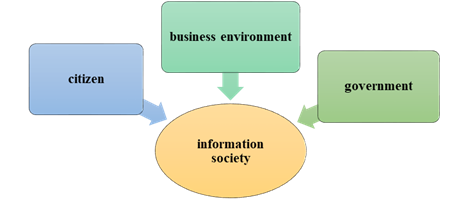
The information society is the result of the application of a legislative package designed to regulate electronic communication at all levels: ♦ citizen ↔ citizen, ♦ citizen ↔ business environment, ♦ citizen ↔ state, ♦ business environment ↔ business environment, ♦ business environment ↔ state. Concrete examples of the implementation of digitization are the information portals of state institutions, online auction software, online payments, online bank transfers / eBanking, electronic certification, electronic archiving, electronic invoicing, online education platforms / eLearning.
In such a highly dynamic computerized society, people are constantly put in new, non-standardized problem situations, to which they must find quick and efficient solutions, proving their skills. Of course, each new experience also helps to identify those units of skills that can be improved. Especially in the business environment, there is a high demand for staff with digital skills. Lack of or low level of digital skills is a real obstacle in the employment of job seekers.
The latest statistics on the Digital Economy and Society Index, DESI 2021, place Romania in the last place among the EU member states (27th out of 27), after, for three consecutive years, it was ranked 26th out of 28 European countries (Table 2).
These country reports, prepared by the European Commission since 2014, are the result of monitoring Member States' digital progress on the following 5 levels: ►human capital, ►connectivity, ►integration of digital technology and ►digital public services (Figure 6).
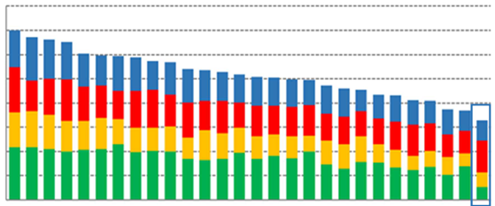
Of the four dimensions measured, the best position occupied by Romania is the 4th place in terms of ICT graduates, which represents 6.3% of all graduates, above the EU average, which is 3.9%. In contrast, more than two-thirds of Romanians do not even have at least basic digital skills (69%), and about 20% of Romanians have never used the Internet, which places Romania in last place in the EU, the last place occupying and for digital public services. In terms of connectivity, we rank 10th in the EU, due to the high percentages of the use of very high-speed broadband services (at least 100 Mbps), 87% of households in Romania have such subscriptions, the same percentages being recorded in the EU.
Digital Skills - Transversal Skills in the Information Society
"The illiterate of the 21st century will not be the ones who can't read and write, but the ones who can't learn, wake up and learn again."
Alvin Toffler (2020)
Being digitally competent means using information and communication technology confidently and critically in work, leisure activities and communication with others.is the ability of a person to select those knowledge, skills and values/attitudes needed to effectively solve a concrete problem situation in the field of ICT.
In the information society, prosperity implies not only the existence of the latest digital technologies but also the ability to exploit and capitalize on their potential. In this sense, an inadequate level of digital skills would be the biggest obstacle to progress and success. The second digital agenda for Europe: 2020-2030 (2020) provides for the continuous updating of digital competencies, which are considered to be cross-cutting competencies, as they underpin other key competencies. Another important goal is to create new digital jobs for ICT experts. The strategic communications of the European Commission (2020), intended for the digital future of Europe, foresee concrete actions for the period 2020-2030, considered the digital decade of Europe, so as to reach 20 milion ICT specialists and at least 80% of the population to have basic digital skills.
Human capital - an indicator of the progress of the digital society
According to DESI 2021 (EC, 2021, p. 9), Romania ranks 26th out of 27 EU countries.
The comparative analysis carried out both horizontally, between the results recorded in Romania and the EU average, and vertically, from one year to another, reveals the following realities (Table 3):
- Only 1 in 3 Romanians has at least basic digital skills, while the EU average is 56%, the increase in the last 2 years compared to 2019 being only 2%.
- Only 1 in 10 Romanians have digital skills above the elementary level, a situation that has remained constant for the last 3 years and which has placed us on the last place in the EU, where 3 out of 10 inhabitants aged 16 to 74 have digital skills above elementary level.
- We have seen a slight increase in digital skills in at least basic software skills, from 32% in 2019 to 35% in 2020 and 2021, which is almost half of the EU average (58%).
- In Romania, ICT specialists represent just over half of the number registered at EU level - 2.4%, compared to 4.3%, in the last 3 years there has been a steady increase of 0.1% per year.
- We see good results for ICT graduates, who represent 6.3% of all graduates, well above the EU average of only 3.9%.
The place of IT professionals in the labor market
There is a dependency relationship between the number of digital jobs in the technical industry and other jobs outside this economic sector. At the EU level, each high-tech job is estimated to generate up to four non-high-tech jobs in the local economy (Goos et al., 2013).
In recent years, there has been the fastest growth in the number of jobs in the field of ICT compared to any other category of jobs. Thus, in the last 10 years, the employment rate of ICT professionals has increased by over 3% per year. Europe is experiencing an acute shortage of skilled people for existing or new jobs in the labor market, which require digital skills. According to European Commission estimates, more than 150,000 IT experts are needed in Europe each year, and studies show that the number of graduates in information technology does not cover the demand in the labor market.
Reducing this digital skills gap is a constant concern of the European Commission, with numerous campaigns such as eSkills Week, eSkills and Jobs and the Grand Coalition for Digital Jobs significantly contributing to reducing this gap from +1 million in 2010, at approx. 700,000. In each EU country, the ICT industry and the European association DIGITALEUROPE have joined forces in such initiatives to increase the number of ICT professionals and reduce the digital skills gap. Cedefop (2018) estimates that in the near future, 90% of jobs will require a certain level of digital skills.
Categories of digital skills
The literature contains references to several types of digital skills. By scope, they can be classified as follows:
Basic digital skills - digital literacy
Professional digital skills - specific to a specific field of activity
Digital ICT specialization skills - for ICT graduates
As digital technology has penetrated all components of human life, the need to use digital devices leads to the integration of digital skills into the category of transversal skills. Having basic digital skills helps to develop the other key competencies in the process called lifelong learning. We use digital skills in the development of communication skills (in the mother tongue and/or in a foreign language), mathematics, science and technology, social and civic, entrepreneurship, cultural expression and, last but not least, the ability to learn to we learn.
We further present a package of digital skills needed by an employee in the field of information technology to ensure success in professional activity (Figure 7).
The skills package is customized according to the nature and complexity of the job, the organizational culture. The modelling of the competencies is done by reference to the attributions registered in the job description, correlated with the institutional development plan, the model/package obtained being able to be used in the situation of hiring, training or evaluating the staff.
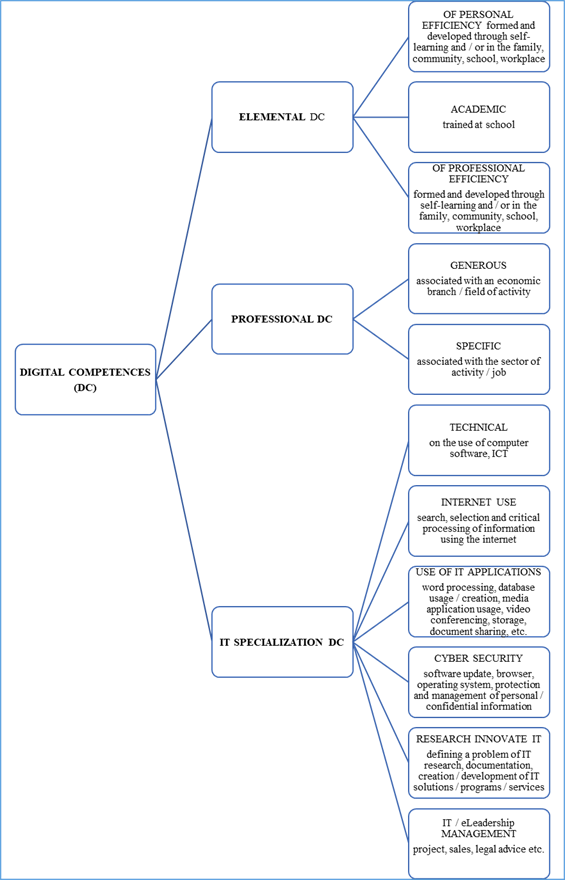
Conclusions
The topic of digital skills is a topical issue, inevitably associated in the literature withand. Tbegins to acquire premises from the family, then its training is carried out in school and continues to develop in adults in the process of(). Taken at the end of the twentieth century in the field of professional qualifications, the termis introduced in pedagogy as a form of learning outcome and the ability of the pupil/student to be demonstrated in concrete situations. Competence does not mean a sum of, but the result of the combined use of these learning acquisitions to solve concrete problem situations.
In the digital field, changes and innovations require a continuous updating of knowledge and skills, participation in continuing education programs being a necessity for maintaining employees and their productivity, with a major impact on the success of the organization, but also on the level of cyber security. The level of digital skills of employees can be either an advantage for a company, if it is high, or a threat, if it is a low one. Unfortunately, in the last three years, Romania occupies the penultimate place in the EU ranking in terms of human resources with digital skills. It is to be appreciated, however, that the authorities are concerned about correcting this deficit through appropriate economic and educational policies.
We believe that the literature will reserve in the near future a much larger space for digital skills associated with an IT employee, the package proposed in this paper can be a starting point for new research.
References
Bell, D. (2021). The Winding Passage: Sociological Essays and Journeys, With a New Foreword by Irving Louis Horowitz. Routledge.
Brzezinksi, Z. (1970). Between Two Ages: America's Role in the Technetronic Era. Viking Press.
Cedefop. (2018). Skills Forecasting: Trends and Challenges to 2030. Publication Office. Cedefop reference series no. 108. https://data.europa.eu/doi/
Ellul, J. (2018). The Technological System. Wipf and Stock.
European Commission. (2018). Communication from the commission to the European parliament, the council, the European economic and social committee and the committee of the regions. The action plan for education digital {SWD (2018) 12 final}. https://eur-lex.europa.eu/legal-content/RO/TXT/PDF/?uri=CELEX:52018DC0022&from=EN
European Commission. (2020). Shaping Europes Digital future. https://commission.europa.eu/system/files/2020-02/communication-shaping-europes-digital-future-feb2020_en_4.pdf
European Commission. (2021). Digital Economy and Society Index (DESI) 2021. https://ec.europa.eu/romania/news/20200611_raport_rezilienta_digitala_ro
European Parliament. (2020). Annual Sustainable Growth Strategy 2021. https://www.europarl.europa.eu/doceo/document/TA-9-2021-0083_EN.html
European Union. (2021). Eurostat regional yearbook. 2021 edition. DOI:
Fraillon, J., Ainley, J., Schulz, W., Friedman, T., & Duckworth, D. (2018). Preparing for life in a digital world. IAE International Computer and Information Literacy Study 2018. International Report. IAE. DOI:
Goos, M., Hathaway, I., Konings, J., & Vandeweyer, M. (2013). High Technology Employment in the European Union. VIVES discussion paper, 41, 1-59. Belgium. https://lirias.kuleuven.be/retrieve/264948
Ikujiro, N., & Takeuchi, H. (1995). The knowledge creating company: how Japanese companies create the dynamics of innovation. Oxford University Press.
Kotler, P. (2008). Marketing Management: Millenium Edition: International Edition. Pearson Prentice Hall.
Toffler, A. (1983). The third wave. Political Publishing House.
Toffler, A. (2020). Future Shock. Bantam Doubleday Dell Publishing Group Inc.
Copyright information

This work is licensed under a Creative Commons Attribution-NonCommercial-NoDerivatives 4.0 International License.
About this article
Publication Date
10 April 2023
Article Doi
eBook ISBN
978-1-80296-961-0
Publisher
European Publisher
Volume
5
Print ISBN (optional)
-
Edition Number
1st Edition
Pages
1-1463
Subjects
Education sciences, teacher education, curriculum development, educational policies and management
Cite this article as:
Iliana, D. (2023). Digital Skills, an Attribute of the Information Society. In E. Soare, & C. Langa (Eds.), Education Facing Contemporary World Issues - EDU WORLD 2022, vol 5. European Proceedings of Educational Sciences (pp. 752-764). European Publisher. https://doi.org/10.15405/epes.23045.75

